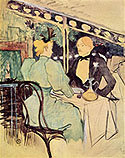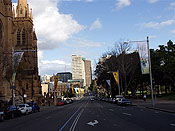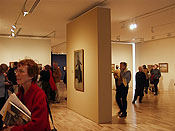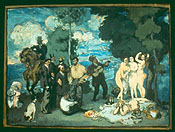The browser will either open the file, download it, or display a dialog.
|
Charles Conder Catalogue by Ann Galbally and Barry Pearce, with a contribution from Barry Humphries. Art Gallery of New South Wales, Sydney, June 14–August 17, 2003; National Gallery of Victoria, Melbourne, September 6–November 9, 2003; Art Gallery of South Australia, Adelaide, November 21 2003–January 26, 2004 |
|||
| In Henri de Toulouse-Lautrec's Fashionable People at Les Ambassadeurs, a handsome young couple is seated at a table in the well-known café-concert on the Champs-Elysées (fig. 1).1 Enjoying a simple supper, they seem to have eyes and ears for one another rather than for the famous Yvette Guilbert, who is crooning one of her sad chansons in the distance. While the woman has not been identified with certainty, the dandyish young man is known to represent the Australian artist Charles Conder (1868-1909) who, in 1890, had come to Paris to study at the Académie Julian.2 His striking figure and classical profile (the British artist A.S. Hartrick thought he had a "head like an antique marble") also appear in Toulouse-Lautrec's well-known program for Marcel Luguet's drama, Le Missionnaire (1894), where his head, in fact, creates the impression of a sculpted bust.3 | |||
| Conder's name is not familiar outside Australia and even in his own country it is not especially well known. The artist's reputation, like that of other Australian expatriates such as John Peter Russell, Rupert Bunny, and E. Phillips Fox, has suffered from the fact that, for decades, no country cared to claim him as its own. Born in London, Conder spent his childhood in India and his formative years in Australia. At age twenty-one, he left for Paris, where he lived on and off until 1900. In that year he moved to London, where he would remain until his death in 1909. | |||
| Though Conder billed himself as an "Australian painter"—no doubt to give himself an aura of exoticism—his works were initially collected by British museums and collectors. The first monograph of the artist and the first loan exhibition were both produced in England.4 It was not until the early 1960s that Australia began to lay claim to Conder. In 1960, Ursula Hoff produced a study of Conder's Australian years, which was followed twelve years later by her monograph of the artist.5 In 1966, the National Gallery of Victoria in Melbourne organized the first retrospective exhibition of Conder's work. Two more books on Conder have appeared since then, a monograph by Sarah Wheatley, published in 1989, and most recently, a biography of Conder authored by Ann Galbally.6 Galbally was one of the prime movers of the exhibition under review, which was developed by Barry Pearce, Head Curator of Australian Art at the Art Gallery of New South Wales. | |||
| Conder's new status as a "national" artist was borne out by the impressive publicity that was made for this retrospective in Australia. Visitors to Sydney, where this reviewer saw the exhibition, were greeted by hundred of banners that alternately proclaimed the artist's name and reproduced one of his early, Australian works (fig. 2). After such hype, the exhibition might have been a disappointment. Filling no more than four admittedly large rooms, it was relatively modest, but its size seemed appropriate for an artist whose career was cut short at age thirty-seven by mental illness (fig. 3). | |||
| The exhibition opened with several painted and drawn portraits of Conder by Toulouse-Lautrec (a sketch for Aux Ambassadeurs), Jacques-Emile Blanche, William Rothenstein, and William Orpen. Collectively, these portraits seemed to suggest that Conder was a familiar figure on the Franco-British art scene of the 1890s with a broad and interesting circle of artist friends. Indeed, shuttling back and forth between Paris and London, Conder was acquainted, with many leading symbolist artists and writers, including Louis Anquetin, Aubrey Beardsley, Augustus John, A.S. Hartrick, Jean Moréas, Charles Ricketts, Walter Sickert, Fritz Thaulow, and Oscar Wilde. A gouache by Anquetin, a study for an illustration that appeared in the Courrier français of February 25, 1894 (not in the exhibition), shows Conder in the company of Anquetin, Moréas, Toulouse-Lautrec, and the latter's roommate, Dr. Henri Bourges (fig. 4).7 | |||
| The exhibition's first gallery was devoted to Conder's Australian years. Like the American expatriate Whistler, Conder started his career as a surveyor, an occupation that left him, as it did Whistler, with ample free time to make landscape sketches in pencil and watercolor. His next job, as an apprentice in a lithography shop in Sydney, brought him one step closer to realizing his dream of becoming an artist. Taking lessons at the Sydney Art Society, where he joined the "sketch club," he began to practice plein-air painting, working in oils with square brushes on small cardboard or wood panels. These early works are among his best and most spontaneous. Delicate, effervescent and often witty, they show that Conder had a natural talent for the sketch. If some of them resemble the art of the Macchiaioli, it is not altogether surprising. Conder spent some time working with Girolamo Nerli, an artist from Florence, who had been living in Australia since 1885. Nerli was one of several European and American artists Conder met in Sydney. Others included the Portuguese Artur José de Souza Loureiro, a follower of Jules Bastien-Lepage; Ugo Catani, a friend of Nerli; and the American Birge Harrison, who had married an Australian wife, a painter as well. All this suggests that Sydney, though less of an art center than Melbourne, was not an artistic backwater, but a place with a small international colony of artists well aware of contemporary movements in Europe. | |||
| In 1888, Conder met Tom Roberts, one of the leaders of the Heidelberg School, a group of landscape painters working outside of Melbourne. Roberts convinced Conder to move to Melbourne, where the young artist would remain for the next two years. The painters of the Heidelberg School practiced a form of plein-air painting that they themselves called "Impressionist," though it came closer to certain forms of French naturalism (like the paintings of Jean-Charles Cazin) and the aestheticism of Whistler in England. Unlike the painters Conder had met in Sydney, those of the Heidelberg School were conscious of their "Australianness." The first generation of artists to have been trained in Australia, they stressed the importance of painting Australian scenes. During his Melbourne period, Conder's landscape paintings became more tonal and thinly painted. A new command of composition compensated for the loss of some of his earlier spark. | |||
| Conder's trip to Paris in 1890 heralded a new phase in his career, which was explored in the next gallery. Living in Montmartre and studying at the Académie Julian, he was exposed to an avalanche of new impressions, both in the realms of life and art. Immersed in Parisian nightlife, he became a heavy drinker and promiscuous lover, contracting the syphilis from which he would die at age 40. Artistically, he was confronted with many, perhaps too many options— Naturalism, Impressionism, Post-Impressionism, Symbolism, British Aestheticism, and various manifestations of Art Nouveau. Though he continued his work as a landscape painter, especially of marine and beach scenes (some of which, like Yport in the York Art Gallery take on a distinctly Symbolist aspect), he became increasingly interested in illustration and decorative painting. This shift in his artistic production was a result, in part, of market factors. Due to the late nineteenth-century interest in totally designed environments, there seems to have been a ready market for decorative paintings, the supply of which was less ample than that of easel paintings. By the mid-1890s, Conder began to make a specialty of painting in watercolors on lengths of silk, which were made into screens and wall panels used in interior decoration, as well as for dresses and fans. Most of his silk paintings were done in a neo-Rococo style inspired by Jean-Antoine Watteau and Jean-Baptiste Oudry on the one hand, and contemporary illustrators like Arthur Rackham, Charles Ricketts, and Georges de Feure, on the other. Elle était une Bergère, a small round silk panel showing a young girl running in the woods, is typical of Conder's silk paintings in its idyllic subject matter, its light palette of moss green, powder blue, yellow and terra cotta, and its slightly melancholy, fairy-tale mood. | |||
| An important factor in the successful reception of Conder's silk paintings was the commission given to him by that great entrepreneur of interior decoration, Siegfried Bing, to paint nine silk panels for a "boudoir." This decorative scheme was to be part of a groundbreaking exhibition of art nouveau interiors in Bing's showroom, La Maison de l'art nouveau (1895). Conder's boudoir was shown side by side with a bedroom by Maurice Denis, a bathroom by Paul Ranson, and a smoking room, dining room, and study, by Henri van de Velde.8 Unfortunately the panels of Conder's boudoir, which appears to have been his most important and successful contribution to decorative silk painting, were not shown in Sydney, nor, for that matter will they be shown in the upcoming Bing exhibition at the Van Gogh Museum in Amsterdam in 2004. The panels are currently in the Yale University Art Gallery, where they form part of the Mabel P. Garvan Collections. According to the museum's records they were acquired, prior to 1937, by Francis Garvan from the collector John Quinn. In permanent storage, they have never been exhibited or photographed. | |||
| Conder's prints and illustrations were shown in the last gallery. Though they were not a commercial success, they do form an interesting part of the artist's oeuvre. Conder made illustrations for an edition of Balzac's La Fille aux yeux d'or and for Ernest Dowson's English translation of Beauty and the Beast. Most interesting in this genre, however, is a series of transfer lithographs that he produced on themes from Balzac. Though done in the neo-Rococo style of his silk panels, these prints have a psychological depth that is missing in those paintings. The lithograph, Esther, for example, shows the body of the courtesan Esther Gobseck (Splendeurs et misères des courtisanes), who has just committed suicide. Several distraught women are moving through the darkened room. The print communicates a sense of violence and anxiety that is altogether missing in the fêtes galantes of Conder's silk paintings. | |||
| In sum, the Conder exhibition presented the artist as a fascinating international figure, who bridged two continents and, once in Europe, two cities—Paris and London. Though naturally gifted, he appears to have been an artist with little self-discipline. Working in a variety of media and styles, he never developed a characteristic manner of his own. Indeed, viewers of the Conder exhibition were left to wonder what direction the work of this chameleon-like artist would have taken had his career extended beyond his premature illness. | |||
| The Conder exhibition catalogue is beautifully produced. It contains color reproductions of all works in the exhibition, a checklist, and informative essays by Barry Pearce, the exhibition curator, Barry Humphries, a major collector of Conder's work, and Ann Galbally, the Australian Conder expert. It is a pity that the catalogue was not copy-edited more rigorously. Numerous typos, grammatical and syntactical slips, and some factual errors mar what could otherwise have been an exemplary work.9 | |||
| Petra ten-Doesschate Chu Professor of Art History Academic Director, MA Program of Museum Professions Seton Hall University, South Orange, New Jersey |
|||
|
1. This sketch was one of a series of seven made as illustrations for an article by Gustave Geffroy, "Le Plaisir à Paris: les restaurants et les cafés-concerts des Champs-Élysées," published in Le Figaro Illustré of July 1893. 2. The painting was doubtlessly based on a portrait study done from life, now in the Aberdeen Art Gallery and Museums (cat. no. 106). 3. Altogether Conder's likeness appears in no less than eight works by Toulouse-Lautrec. For a complete listing, see Herbert D. Schimmel, ed., The Letters of Henri de Toulouse-Lautrec (Oxford/New York/Toronto: Oxford University Press, 1991), 306, letter 483, n. 2. 4. The monograph was written by John Rothenstein, the son of Conder's friend, the painter William Rothenstein (The Life and Death of Conder. Dent: London, 1938). The first loan exhibition of Conder's art was held at the National Gallery in London London, National Gallery (1927). 5. Ursula Hoff, Charles Conder: The Australian Years (Melbourne: National Gallery of Victoria Society, 1960) and Charles Conder (Melbourne: Landsdowne Press, 1972) 6. Sarah Wheatley, Charles Conder 1968-1909 (Sydney: Mallard Press, 1989) and Ann Galbally, Charles Conder: The Last Bohemian (Melbourne: Miegunyah Press, 2002). 7. I thank Dennis Cate, curator at the Jane Voorhees Zimmerli Art Museum, for bringing this work to my attention. The Zimmerli Museum also possesses a small sketch by Conder himself, Profils au Café du Rat Mort, 1892. 8. For more on this exhibition, see Salon de L'Art Nouveau, Premier Catalogue, Paris, 1895, number 48. Here there was a reference to "Décoration d'un boudoir, peinture sur soie" without any reference to the total number of works that were included under this single catalogue entry number. Conder is briefly noted in Gabriel P. Weisberg, Art Nouveau Bing, Paris Style 1900 ( Harry N. Abrams and the Smithsonian Institution Traveling Exhibition Service,1986), 66. 9. Some of the more egregious examples include: (throughout) Samuel Bing should be Siegfried; (p. 43) peintre d'essence should be peinture d'essence; (p. 53) van Wisselburgh should be van Wisselingh; (p. (p. 140)) Georges du Feure should be Georges de Feure; (p. 141) Garvan College should be Garvan Collection; (p. 159): Paul Vuillard should be Édouard Vuillard; (p. 160) pointe d'Angleterre should be point d'Angleterre; p. 182: Germiné Lacerteux should be Germinie (p. 199) rue Ravignon should be rue de Ravignan).
|






